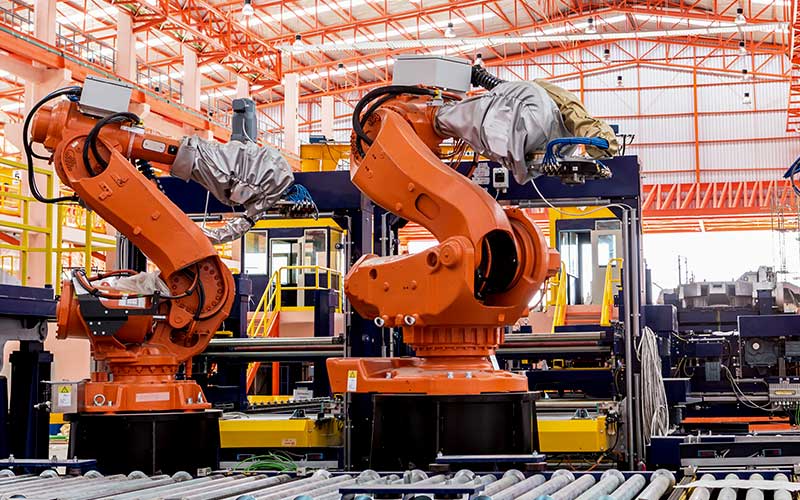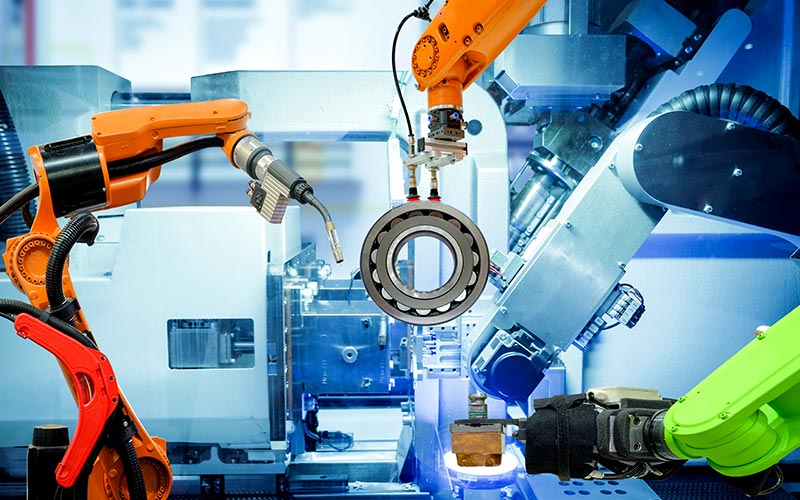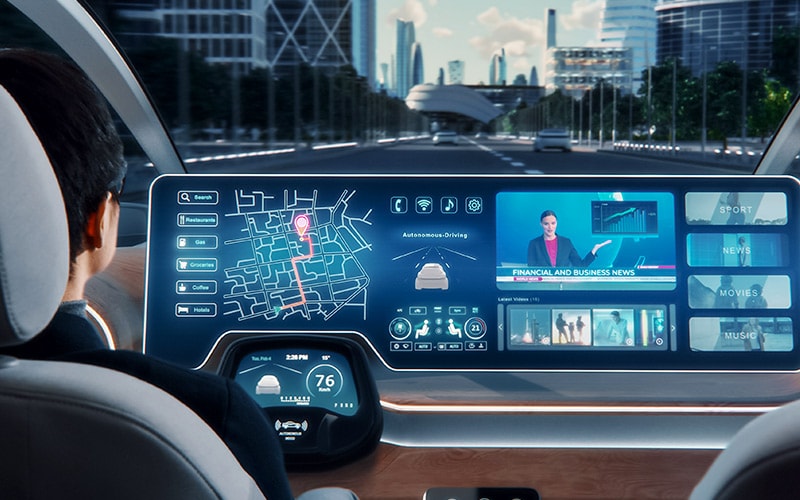Servitization and Industry 4.0 have received much attention from businesses recently. What has not been so clear is the connection between the two. Industry 4.0 is internal facing and usually stops with the shop floor. But through servitization, it can be extended to the customer to support more holistic and potentially circular business models.
The world is at the beginning of a new era of industry. Coined by Klaus Schwab as the “Fourth Industrial Revolution”, this era will bring unprecedented change to how we design, source, make, distribute and use physical products. Importantly, it is an era that moves beyond the physical and utilizes digital connectivity and autonomous processes to enable leaps forward in efficiency and possibility.
In response to this, the manufacturing industry is adopting the concept of Industry 4.0. This is about implementing a “smart factory” – one that is connected, using analytics and virtual models for simulation with autonomous decision-making.
Yet another separate concept is evolving alongside Industry 4.0 – “servitization”, which is the process by which services are bundled together with a physical product. But it is increasingly coming to describe products that are sold as services, typically on a pay-per-usage basis. The most common example is Rolls-Royce’s “power-by-the-hour” approach, where it sells aircraft engines on a fixed cost basis, with all maintenance and replacement included in the price.
But more recently, this concept has been launched for consumer products such as Nura headphones, which can be personalized to a user’s hearing profile and upgraded automatically through a subscription service. Apple is also entering this field with its new subscriptions that bundle network connectivity with hardware upgrades across multiple products.
Our view is that Industry 4.0 and servitization need to be seen as two sides of the same coin.
Both are underpinned by emerging technologies that enable autonomous and flexible systems such as the internet of things for seamless machine-to-machine communication and 5G for data connectivity, data analytics to support fact-based decision making, along with the use of “digital twins” for simulations and, finally, rapid autonomous decision making through artificial intelligence.
Moreover, these approaches support each other. If Industry 4.0 is the operational construct by which a product is created efficiently in a factory, then servitization is the model through which it is consumed effectively by the end customer. In an increasingly circular world, both need to be designed with the other in mind to maximize efficiency and re-usability at a product’s end-of-life.
For this reason, it is helpful to have a framework to understand the linkages between these two concepts. We believe that the Industry 4.0 maturity index developed by Infosys in partnership with Aachen University and the acatech consortium can be a strong starting point.
Servitization: services to subscriptions
There are several expert opinions defining servitization and Industry 4.0. Sandra Vandermerwe and Juan Rada used the term “servitization” for the first time in their publication in 1988. According to them “servitization of business” is “bundles of customer-focused combinations of goods, services, support, self-service, and knowledge.”1 Tim Baines et al. refer to servitization as “a process of building revenue streams for manufacturers from services.”2
These bundles of services are seen by many manufacturers as a way to add value to their physical products, which themselves are becoming more digitally enhanced. The automotive industry is perhaps the most active in exploring this as a transformative theme. Many manufacturers are using the concept of servitization to position themselves as holistic “mobility” providers. Instead of focusing on the sale of a single car, they are looking to provide a wraparound of personalized digital services to consumers that enhance their travel experience – be it through in-car services, by sharing access to a car, or by partnering with other transport providers in a metropolitan area.
This thinking typically goes hand in hand with the emergence of subscription payments for bundled services. The benefit of these to a manufacturer is that they can offer better visibility of cash flow and demand. The constant engagement with the consumer, through the subscription and insight into usage of the product, also enables them to predict maintenance schedules – again with an eye on better cost management.
Indeed, Gebauer et al. tackled this issue in 2017 when they explored servitization as a pay-per-use service.3 They described the organizational capabilities required to shift to such a business model, such as financing services, aligning cost with equipment usage and customer collaboration.
It is these areas where servitization begins to interact and overlap with Industry 4.0. In order for a business to align its costs with usage of its product, collaborate with customers to gain insights on the product usage, and finance this new model, the stages of Industry 4.0 can help.
The Industry 4.0 maturity index
The basic tenets of Industry 4.0 are i) interconnection for machines to talk to each other, ii) information transparency for fact-based decision making, iii) technical assistance to assist humans in decision making by aggregating and visualizing information and iv) decentralized decisions for systems to make decisions on their own. Depending on an organization’s appetite or capability, these four elements can be differently implemented and prioritized.
Infosys published an index that serves as a roadmap for Industry 4.0 in collaboration with Aachen University and the acatech consortium in 2017.4 The index defines the following four levels of maturity for Industry 4.0 adoption (Figure 1). It assumes that basic computerization and connectivity are alreadyz available – Industry 3.0 in other words.
Figure 1. The industry 4.0 maturity index and the stages of adoption
The four levels of maturity and what they mean for organizations are as follows:
- Visibility - An organization has achieved visibility when it can “see” what is happening in its organization or the shop floor specifically. Key parameters are measured using sensors and fed to appropriate visualization tools such as dashboards for decision makers to see and take action.
- Transparency - The next level in maturity or transparency is achieved when the data gathered in the previous level is used to perform root cause analysis and understand why key events happen the way they do. It helps take corrective action.
- Predictability - This level of Industry 4.0 is reached when the insights from the previous two levels can be used to take proactive action. What-if analysis can be conducted for various scenarios to decide what action to take before they happen.
- Adaptability - Adaptability is the ideal state in Industry 4.0 when systems have autonomous capability to make rational decisions on their own without human intervention.
Connecting the shop floor to customers
A crucial component of Industry 4.0 is its connectivity to operational activities beyond the factory shop floor. Proponents of the model advocate for “IT-OT convergence”. IT or information technology consists of traditional sources of information – master databases for customers, products, plans and processes. OT or operational technology is the information that happens in the shop floor – master systems for assets used for making, manufacturing execution systems and key process parameters in the creation of products. Industry 4.0 integrates these two islands of information to seamlessly talk to each other (Figure 2) for timely decision-making.
But this needs to go much further if Industry 4.0 is to truly support a business to become an agile organization that senses and responds to its customers, employees and ecosystem – what Infosys calls a “Live Enterprise”, in which large organizations are able to sense, process and respond to information in real time, like living organisms.
Figure 2. Industry 4.0 for IT-OT convergence - integrating the top floor and the shop floor
Industry 4.0 enables a “Live Enterprise” at the level of product design, sourcing, making, assembly, distribution, usage and end-of-life. However, it is sorely lacking when it comes to the commercial framework by which the product is marketed and sold, as well as managing the customer relationship and inputs with the product and brand.
Industry 4.0 supports Live Enterprise from product designing, sourcing, making, assembling, distributing to the end of its life
The way customers pay for a product and their expectations around servicing and upgrades need to be a big input into planning for Industry 4.0 processes. Servitization can play an important role here because it increases the touch points and extends the relationship with the customer through value-added and subscription-based services. Moreover, these touchpoints are increasingly digital in nature, aligning well with the digital connectivity and automation that Industry 4.0 is founded upon.
Figure 3 describes how Industry 4.0 can be extended to incorporate the customer through servitization. Indeed, the Industry 4.0 index is an effective way to understand the relationship between these two concepts.
- Visibility - This basic level of servitization enables ‘connected products’ for a pay-per-use subscription based business model. Equipment makers can keep track of the performance of their products. Customers can be billed based on the actual usage of a product.
Printer makers are early adopters of such connected products to implement a pay-per-page revenue model, based on the number of pages printed.6 Along with this model, tracking of toner usage helps top up the toner before the printer runs out of it.
- Transparency - At this second level of servitization, the product performance gathered remotely using connected products can be used to conduct root-cause-analyses for critical incidents. Proactive action can be taken before problems occur by closely monitoring trends and patterns of events that lead to an unwanted situation.
JCB’s LiveLink is an example of telematics-based remote management, which JCB uses for its fleets of vehicles. Alerts for critical situations such as low oil pressure or coolant level and high coolant temperature are provided. Incorrect operation of vehicles or any missed daily maintenance activities are conveyed to a central control to plan for repair work proactively. Such measures help in reducing fuel consumption while increasing machine utilization. These alerts and messages can help in root cause analysis for unexpected or critical events.
- Predictability - Predictability offers the capability to conduct simulations on virtual replicas of physical systems or products. These replicas or ‘digital twins’ mimic the behavior of real-life systems. They can be used to test how products are expected to behave under different situations and to decide what action has to be taken by whom.
GE Aviation uses a digital twin to monitor the performance of its aircraft engine blades. It is a digital model of a physical asset built by collecting data from IoT sensors to analyse the data and gain unique insights about product performance.7 Digital twins predict how a blade will perform and degrade, in specific conditions such as erosion due to sandy conditions, in desert areas like the Middle East.
- Adaptability - This is the ideal state of a product where it has been trained using historical information to make a decision on its own. Its operation can be optimized.
Tesla’s autopilot feature is an example of autonomous operation. It uses external-facing cameras and other sensors to offer assisted driving.8 Although not achieving fully autonomous operation, the feature helps drivers by providing services such as cruise control on highways, navigation and auto-steering.
Figure 3. Servitization integrating the top floor, shop floor and customer

Two sides of a coin
Industry 4.0 is incomplete without servitization; both need to be designed together. The body of research into the interface between the two is growing. In their recent article on the convergence of Industry 4.0 and servitization, Alejandro G. Frank et al. explored these two trends as a technology-push driven by competition and demand-pull from customers respectively.9 They analyzed the different configurations and interfaces of different types of servitization and different levels of digitization, shining more light on this relationship.
Industry 4.0 is incomplete without servitization; both need to be designed together
What is clear is that Industry 4.0 is an incomplete model without effective input from the customer and their commercial relationship and engagement with the end product.
White goods manufacturer Whirlpool serves as a cautionary example for the Industry 4.0-servitization journey. The company introduced a Wi-Fi-enabled washing machine with a mobile app for control in 2014; it was not popular in the market.
According to Chris Quatrochi, global director of user experience and connectivity, “Trying to understand exactly the value proposition that you provide to the consumer” was a challenge.10 The app provided visibility for the machine status. But it was not of significant value to the customer or Whirlpool.
It’s a lesson for all that are embarking on an Industry 4.0 transformation. Don’t forget the customer, or the value they see in the product and service. Industry 4.0 and servitization are both distinct areas, but both need to be designed in concert from the early stages to effectively amplify their benefits, both for the product maker and the end user.
References
- Vandermerwe, Sandra, and Rada, Juan,Servitization of Business : “Adding Value by Adding Services”, European Management Journal. p.314-324, 1988
- Baines, Tim et al, “Servitization: revisiting the state-of-the-art and research priorities”, International Journal of Operations & Production Management, 2017
- Gebauer, Heiko & Saul, Caroline Jennings & Haldimann, Mirella & Gustafsson, Anders, “Organizational capabilities for pay-per-use services in product-oriented companies,” International Journal of Production Economics, Elsevier, vol. 192(C), pages 157-168, 2017
- Schuh, G., Anderl, R., Gausemeier J., ten Hompel, M., Wahlster, W. (Eds.): “Industrie 4.0 Maturity Index. Managing the Digital Transformation of Companies (acatech STUDY)”, Munich: Herbert Utz Verlag 2017
- Ravikumar GVV and Enose, Nampuraja, “Making Industry 4.0 real – using the acatech I4.0 maturity index”, whitepaper, 2017
- How IoT solutions supercharge managed services -https://www8.hp.com/za/en/services/printer-security/how-iot-solutions-supercharge-managed-services.html
- Digital Twin framework - https://www.ge.com/research/project/digital-twin-framework
- Autopilot and full self-driving capability, https://www.tesla.com/support/autopilot
- Frank, G. Alejandro et al, :Servitization and Industry 4.0 convergence in the digital transformation of product firms: A business model innovation perspective”, Technological Forecasting and Social Change Volume 141, Pages 341-351, 2019
- Harwell, Dave, Whirlpool’s “Internet of Things” problem: No one really wants a “smart” washing machine, https://www.washingtonpost.com/news/the-switch/wp/2014/10/28/whirlpools-internet-of-things-problem-no-one-really-wants-a-smart-washing-machine/, 2014







